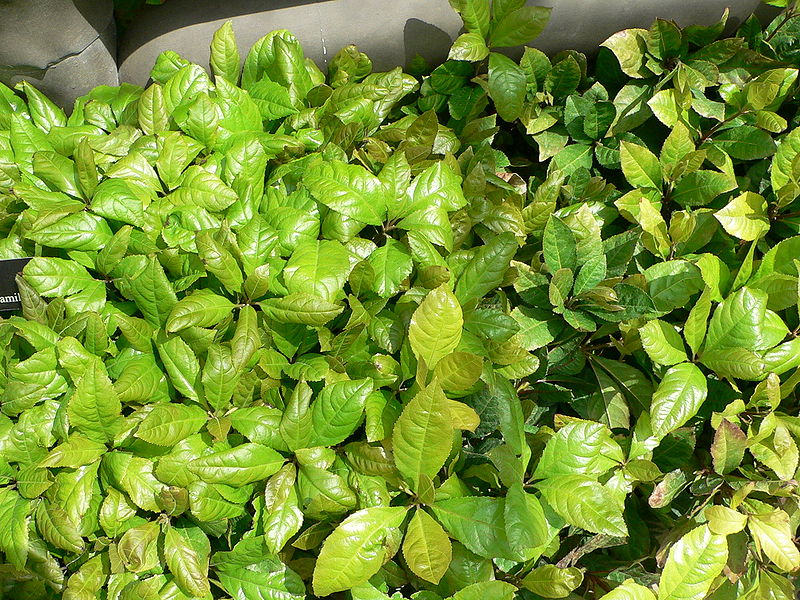 |
|
http://commons.wikimedia.org/wiki/User:Raul654 |
 |
|
Translate this page:
Summary
Bloom Color: White.
Main Bloom Time: Mid summer. Form: Prostrate, Variable spread.
Physical Characteristics

 Ardisia japonica is an evergreen Shrub growing to 0.5 m (1ft 8in) at a medium rate.
Ardisia japonica is an evergreen Shrub growing to 0.5 m (1ft 8in) at a medium rate.
See above for USDA hardiness. It is hardy to UK zone 8. It is in leaf all year, in flower from August to September, and the seeds ripen from December to March. The species is hermaphrodite (has both male and female organs).
Suitable for: light (sandy), medium (loamy) and heavy (clay) soils and prefers well-drained soil. Suitable pH: mildly acid, neutral and basic (mildly alkaline) soils. It can grow in semi-shade (light woodland). It prefers moist soil.
UK Hardiness Map
US Hardiness Map
Synonyms
Plant Habitats
Woodland Garden Dappled Shade; Shady Edge; Hedge;
Edible Uses
References More on Edible Uses
Medicinal Uses
Plants For A Future can not take any responsibility for any adverse effects from the use of plants. Always seek advice from a professional before using a plant medicinally.
Antidote Antitussive Cancer Carminative Depurative Diuretic Expectorant
This plant is commonly used in Chinese herbalism, especially in cases of bronchitis, where it is considered to be one of the 50 fundamental herbs[218]. Carminative, depurative, expectorant, stimulates blood circulation[147, 178]. The leaves are used in the treatment of cancer and hepatoma[218]. A decoction of the stems is used in the treatment of coughs and uterine bleeding[218]. The root is antidote and diuretic[218]. The plant is depurative[218].
References More on Medicinal Uses
The Bookshop: Edible Plant Books
Our Latest books on Perennial Plants For Food Forests and Permaculture Gardens in paperback or digital formats.

Edible Tropical Plants
Food Forest Plants for Hotter Conditions: 250+ Plants For Tropical Food Forests & Permaculture Gardens.
More

Edible Temperate Plants
Plants for Your Food Forest: 500 Plants for Temperate Food Forests & Permaculture Gardens.
More

More Books
PFAF have eight books available in paperback and digital formats. Browse the shop for more information.
Shop Now
Other Uses
References More on Other Uses
Cultivation details
Landscape Uses:Container. Prefers a well-drained humus rich soil in partial shade in a position sheltered from cold drying winds[200]. Hardy to about -10°c, it succeeds outdoors in S.W. England[1] but is not wholly hardy at Kew[11]. It does well in a woodland situation[166]. A number of cultivars have been developed for their ornamental value[182]. Special Features:
Attractive foliage, Not North American native, Invasive, Fragrant flowers.
References Carbon Farming Information and Carbon Sequestration Information
Temperature Converter
Type a value in the Celsius field to convert the value to Fahrenheit:
Fahrenheit:
The PFAF Bookshop
Plants For A Future have a number of books available in paperback and digital form. Book titles include Edible Plants, Edible Perennials, Edible Trees,Edible Shrubs, Woodland Gardening, and Temperate Food Forest Plants. Our new book is Food Forest Plants For Hotter Conditions (Tropical and Sub-Tropical).
Shop Now
Plant Propagation
Seed - best harvested when it is ripe in the winter and sown immediately in a greenhouse[1]. Sow stored seed as early in the year as possible. When large enough to handle, prick the seedlings out into individual pots and grow them on in a shady part of the greenhouse for at least their first winter. Plant out into their permanent positions in late spring or early summer, once the plants are 20cm or more tall. Cuttings of half-ripe wood in summer[200]. Grow on in cool, shaded humid conditions until well rooted[200].
Other Names
If available other names are mentioned here
Native Range
TEMPERATE ASIA: China (Anhui Sheng, Zhejiang Sheng, Fujian Sheng, Hunan Sheng, Hubei Sheng, Jiangxi Sheng, Jiangsu Sheng, Guizhou Sheng, Shaanxi Sheng, Sichuan Sheng, Yunnan Sheng, Guangxi Zhuangzu Zizhiqu), Japan (Hokkaidô (south), Honshu, Kyushu, Shikoku), Korea, South, Taiwan
Weed Potential
Right plant wrong place. We are currently updating this section.
Please note that a plant may be invasive in one area but may not in your area so it's worth checking.
Conservation Status
IUCN Red List of Threatened Plants Status :

Growth: S = slow M = medium F = fast. Soil: L = light (sandy) M = medium H = heavy (clay). pH: A = acid N = neutral B = basic (alkaline). Shade: F = full shade S = semi-shade N = no shade. Moisture: D = dry M = Moist We = wet Wa = water.
Now available:
Food Forest Plants for Mediterranean Conditions
350+ Perennial Plants For Mediterranean and Drier Food Forests and Permaculture Gardens.
[Paperback and eBook]
This is the third in Plants For A Future's series of plant guides for food forests tailored to
specific climate zones. Following volumes on temperate and tropical ecosystems, this book focuses
on species suited to Mediterranean conditions—regions with hot, dry summers and cool, wet winters,
often facing the added challenge of climate change.
Read More
Expert comment
Author
(Thunb.)Blume.
Botanical References
1158200
Links / References
For a list of references used on this page please go here
Readers comment
© 2010, Plants For A Future. Plants For A Future is a charitable company limited by guarantee, registered in England and Wales. Charity No. 1057719, Company No. 3204567.